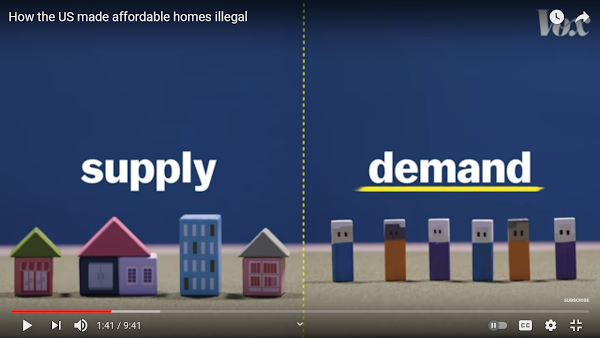Housing supply and demand in one screenshot.
The above screenshot and stats are from a beautifully done video illustrating the various forces at play in the US housing market currently. Demand is high but there is a terrible mismatch between the kind of housing we need and the kind of housing we are building.
In the 1980s, starter homes made up about 40 percent of new housing. Now it's around 7 percent.
Between lot size minimums, height restrictions and other zoning restrictions, we are making it nearly impossible to build the kind of housing we really need.
After failing to build enough starter homes for people who would have historically been viewed as middle class, we then blame them if they get pushed out into the street. We trot out accusations of drug addiction and personal problems rather than acknowledging that we simply aren't building enough housing to begin with, especially not housing of the right kind.
We are designing a world that actively cuts out anyone who isn't already wealthy. And then we compound that problem by trying to design programs to "help the poor."
Counterintuitively, solutions aimed at helping poor people or helping the homeless frequently make things worse, not better. Poverty is expensive which is what keeps people trapped in it and solutions designed for "poor people" are frequently designed with the implicit assumption that you are a bad person and you don't really deserve good things.
If you don't have much money but also don't need much to live on and can save part of it, people don't describe that as poverty. They describe it as minimalism or simple living or part of a plan to retire early (a la FIRE).
Middle class solutions tend to be solutions with low life-time costs. Solutions aimed at poor people often come with low upfront costs but high carrying costs which add up to high overall costs.
Solutions that help people better themselves will have both an affordable up-front cost and a reasonable life-time cost. These are generally viewed as middle class solutions and we have too few such available today.
Poverty housing routinely lacks good access to public transit, fails to be near shopping and is often nowhere near job opportunities. Housing for college students or seniors or first-time home buyers is much more likely to be designed with access to all the amenities one needs to live a full life.
Ideally, you don't want to put a lot of restrictions on who can live there.
If you design housing with the idea that "College students might want to live here" that will tend to get you better housing than if you design housing for "poor people." But designing housing and then restricting it to college students only tends to create problems and hamper both stability and upward mobility.
There is a huge mismatch currently between the kind of housing we need and the kind of housing that is available. There is also a general shortage of housing because we have underbuilt for decades. This double-whammy is one of the things actively forcing people out into the streets.
We need more housing. It needs to be housing with a reasonable cost.
Historically, we knew how to build such housing. We still can if we want to, though it will require repealing restrictions that are currently pushing up costs all over the US.
